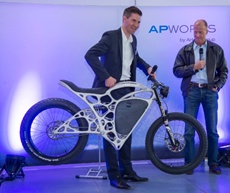Airbus subsidiary develops world's first 3D-printed electric motorcycle
21 May 2016
APWorks, a subsidiary of Airbus Group, has developed the world's first 3D-printed motorcycle, the Light Rider.
 | |
| Joachim Zettler (left), CEO of Airbus APWorks GmbH, and Airbus Group CEO Tom Enders presenting 'Light Rider', the world's first 3D-printed motorcycle |
The motorbike weighs only 35 kg, is about 30-per cent lighter than most conventional e-motorcycles. It goes from 0 to 80 km in seconds and can travel close to 60 km between charges.
APWorks said in a statement, "With a 6 kW electric motor powering it from zero to 80 km per hour in just seconds and a frame boasting a mere 6 kg, the world's first 3D-printed electric motorcycle is 30-per cent lighter than conventionally manufactured e-motorcycles."
The bike printed at APWorks' uses proprietary Scalmalloy material, an alloy of aluminium, which is resistant to corrosion and is about as strong as titanium. The Light Rider owes its light weight to its hollow frame, which was produced via selective laser melting and looks like a fragile, silvery web.
However, it is not fragile and can take as much weight and stress as any normal motorcycle.
''The complex and branched hollow structure couldn't have been produced using conventional production technologies such as milling or welding,'' said Joachim Zettler, CEO of Airbus APWorks GmbH. ''Advances in additive layer manufacturing have allowed us to realise the bionic design we envisioned for the motorcycle without having to make any major changes. With these technologies, the limitations facing conventional manufacturing disappear.''
APWorks is taking orders for a limited run of 50 motorcycles, costing €50,000 ($56,095), plus tax, each.
3D-printing technologies have revolutionised the design and manufacturing process – not only in terms of structure and aesthetics, but also in impressive weight savings on parts and equipment when compared to those made using conventional manufacturing techniques.
APWorks used an algorithm to develop the Light Rider's optimised structure to keep weight at a minimum while ensuring the motorcycle's frame was strong enough to handle the weight loads and stresses of everyday driving.
The result? A motorcycle that looks more like an organic exoskeleton than a machine. That was a very deliberate design goal for APWorks, which programmed the algorithm to use bionic structures and natural growth processes and patterns as the basis for developing a strong but lightweight structure.






























